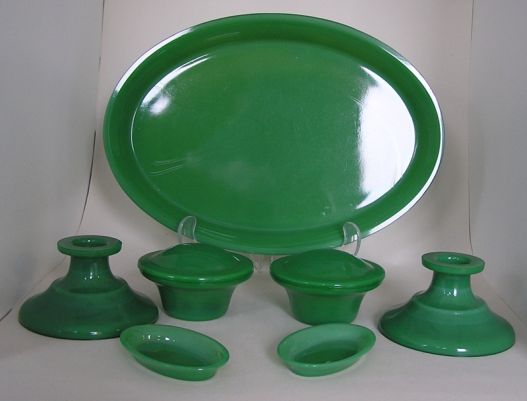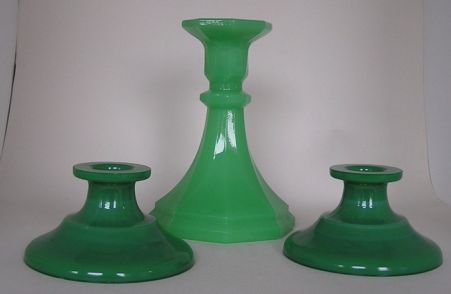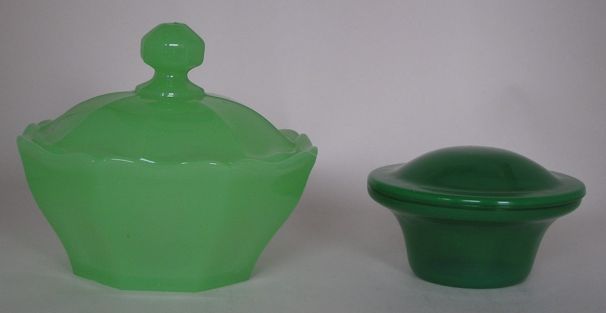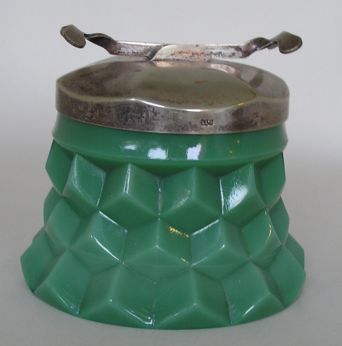|
|
|||||||||||||||||||||||
|
|||||||||||||||||||||||

Jade coloured glass was a popular colour in the 1930s and many companies made part of their range in this shade of green. The name Jade is very apt as it is does look like the semi-precious stone Jade, which was highly prized and expensive. The exact shade of green glass varied from manufacturer to manufacturer. As we shall see Davison Jade was quite unlike any other.
A note in the glassmakers’ production records states that Davidson’s started producing their Jade glass in January 1931. It was first displayed to trade buyers at the British Industries Fair in February of that year. A report of the exhibit was published in the Pottery Gazette in April. Their reporter commented:
“...this year witnesses the marketing of another colour – this time a beautiful jade. We congratulate Davidson & Co. upon the way this was displayed. An alcove, having a background of black velvet, was entirely reserved for a full range of this new jade colouring, and we have grounds for believing that it was one of the talks of the Fair.”
Jade was expensive to produce. The wholesale price of Jade glass was the same as for the cloud colours. For example, a dozen 696 pattern flower bowls would have cost 72 shillings wholesale - £3.60p in today’s money. The cost of the same bowls in plain amber glass was 54 shillings, or £2.70.
 Unlike other manufacturers' Jade, Davidson Jade is very
dull or flat in appearance.
When held up to the light it can appear transparent, sometimes with trails like
Cloud Glass. The colour can also be very variable, not only between different
batches, but also in the same article! This is illustrated in the picture,
right, of a Jade 279 10" Column vase. The top of the vase is a much paler
shade of green, almost white in colour. The effect is often more noticeable
in D type flower bowls with turned down rim. The rim is often much lighter
in colour; this probably resulting from reheating the glass in the glory
hole. Unlike other manufacturers' Jade, Davidson Jade is very
dull or flat in appearance.
When held up to the light it can appear transparent, sometimes with trails like
Cloud Glass. The colour can also be very variable, not only between different
batches, but also in the same article! This is illustrated in the picture,
right, of a Jade 279 10" Column vase. The top of the vase is a much paler
shade of green, almost white in colour. The effect is often more noticeable
in D type flower bowls with turned down rim. The rim is often much lighter
in colour; this probably resulting from reheating the glass in the glory
hole.When making Jade the glass had to be used quickly, otherwise in lost its colour. Sheilagh Murray in her book 'The Peacock and the Lions' tells of how potatoes would be placed on a long rod and placed in the pot of molten glass to 'Physic' the metal and restore the colour. This technique was known as blocking(1) or tattying and was used in the glass industry to mix the melt thoroughly or to remove fine bubbles of glass in the mix. The potatoes would produce large bubbles of steam which would help stir the metal. The rising steam bubbles would also help to sweep away any fine bubbles in the melt. |
 Davidson
jade was very different in appearance to other forms of jade Glass. This is
illustrated in the next two photographs. The first is of a Jobling jade
Candlestick with a pair of Davidson 326 Candlesticks and the second shows a
Reich Viktoria Jade Powder bowl with a Davidson 325 powder bowl. In both
cases the Davidson jade can be seen to be much darker in colour and also
dull in appearance. The colour of the Jobling and Reich jade is very even,
again unlike Davidson Jade. The Jobling jade, which is technically called
Uranium Moonstone, and the Reich jade contain small amounts of Uranium
Trioxide. This makes the glass fluoresce under UV light and also makes them
slightly radioactive. Davidson jade is not. Jobling introduced their jade in 1933. We are not
sure when Reich made their version of Jade. Bagley’s also produced a similar
glass, a paler green opal glass called Crystopal, which they introduced in
1947. Davidson
jade was very different in appearance to other forms of jade Glass. This is
illustrated in the next two photographs. The first is of a Jobling jade
Candlestick with a pair of Davidson 326 Candlesticks and the second shows a
Reich Viktoria Jade Powder bowl with a Davidson 325 powder bowl. In both
cases the Davidson jade can be seen to be much darker in colour and also
dull in appearance. The colour of the Jobling and Reich jade is very even,
again unlike Davidson Jade. The Jobling jade, which is technically called
Uranium Moonstone, and the Reich jade contain small amounts of Uranium
Trioxide. This makes the glass fluoresce under UV light and also makes them
slightly radioactive. Davidson jade is not. Jobling introduced their jade in 1933. We are not
sure when Reich made their version of Jade. Bagley’s also produced a similar
glass, a paler green opal glass called Crystopal, which they introduced in
1947. |
 The
problems, and the expense, of making Jade meant that it was made only for a short
time. In February 1933 Davidson introduced their new Emerald green colour at the
British Industries Fair. The Pottery Gazette reporter wrote:
The
problems, and the expense, of making Jade meant that it was made only for a short
time. In February 1933 Davidson introduced their new Emerald green colour at the
British Industries Fair. The Pottery Gazette reporter wrote:
“A new colour was on view – an emerald green – offered in both clear and matt finishes. This at once attracted the attention of Her Majesty the Queen on her visit to the stand, and several pieces of it were purchased by her….we doubt not that the tour de force of the present season will be the new clear emerald”.
The following year at the British Industries Fair Davidson’s next innovative colour was on display – Green Cloud glass. These two new colours sounded the death knell for Jade. Production of Jade glass stopped in April 1934.
Because of this limited run, Jade is quite rare and is sought after by collectors. We can gain some idea of the amount of Jade produced from Davidson's production records. Sadly we do not have the complete production record as the records for 1931 have not survived. The table below gives the number of articles produced in Jade which passed inspection (i.e. were not seconds) from February 1932 onwards:
|
|
 Jade was used to make a lot of domestic glassware such as sugars,
ashtrays, dishes etc. as well as the fancy line in glassware such as flower bowls
and vases. This is in stark contrast to the Cloud colours which were, with a few
exceptions, only made in the fancy glassware line. One or two odd examples of
Jade have turned up over the years. One example is this sugar bowl. The pattern
is called Georgian and was imported by the National Glass Company, who also
imported Chippendale glass. In 1930, Davidson began to make Chippendale for the
National Glass Company, eventually buying the moulds. Georgian Glass was first
imported into the UK at about the same time as Chippendale and initially was
advertised heavily. By the late 1920s, the Georgian adverts had disappeared,
only Chippendale was advertised widely. Why Davidson should make a sugar bowl in
an expensive glass, presumably for the National Glass Company, at a time when
its popularity was waning is a puzzle. Examples of this sugar bowl are also
known in clear flint glass.
Jade was used to make a lot of domestic glassware such as sugars,
ashtrays, dishes etc. as well as the fancy line in glassware such as flower bowls
and vases. This is in stark contrast to the Cloud colours which were, with a few
exceptions, only made in the fancy glassware line. One or two odd examples of
Jade have turned up over the years. One example is this sugar bowl. The pattern
is called Georgian and was imported by the National Glass Company, who also
imported Chippendale glass. In 1930, Davidson began to make Chippendale for the
National Glass Company, eventually buying the moulds. Georgian Glass was first
imported into the UK at about the same time as Chippendale and initially was
advertised heavily. By the late 1920s, the Georgian adverts had disappeared,
only Chippendale was advertised widely. Why Davidson should make a sugar bowl in
an expensive glass, presumably for the National Glass Company, at a time when
its popularity was waning is a puzzle. Examples of this sugar bowl are also
known in clear flint glass.
Jade remains a popular colour with collectors and prices are similar to those of Amber Cloud Glass.
Notes:
1) We are grateful to Adam Dodds, former Glass technologist at Davidson, for explaining the purpose of blocking. Adam has very kindly shared his vast experience with us for the web site and also to others on the Glass Club Message Board www.glassmessages.com.
|
|
|
|